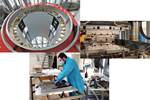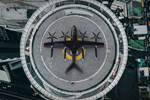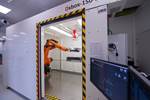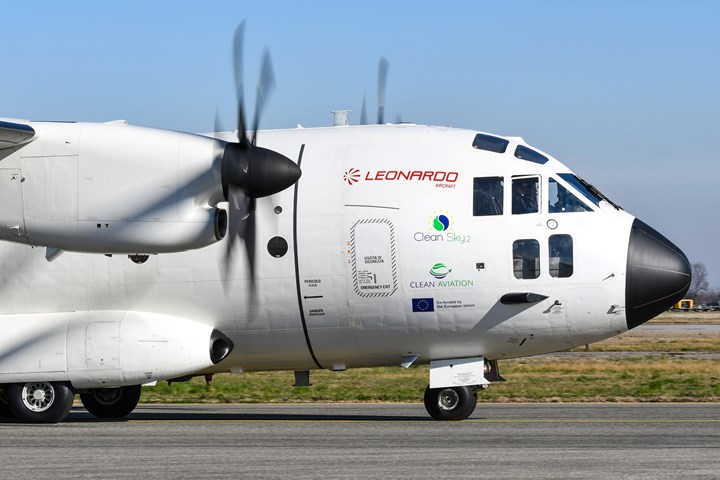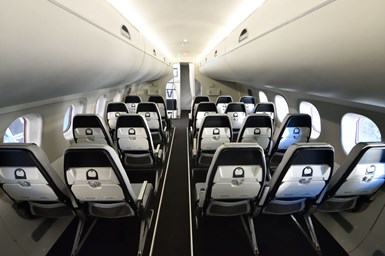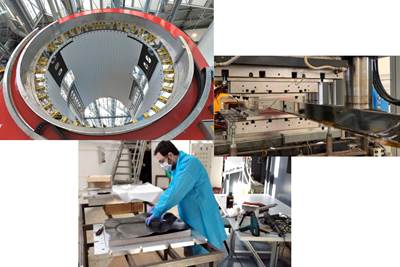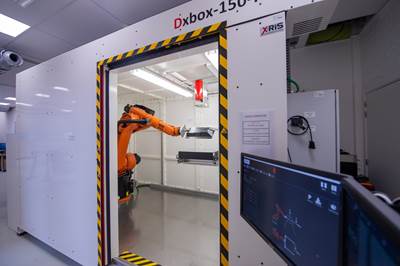Leonardo advances sustainable aerospace innovation testing
Wingtips and morphing winglets integrated into a C-27J flying test bed, and a full-scale composite fuselage, are undergoing testing for Clean Sky 2 programs.
Share
Leonardo (Rome, Italy) has concluded the Regional Integrated Aircraft Demonstration Platform (REG IADP) campaign with its C-27J flying test bed, a Clean Sky 2 program technological demonstration aircraft to test innovative morphing surfaces with adaptive technologies and digital flight control algorithms in effort to deliver more sustainable aircraft. Moreover, it continues the testing of the Pax Cabin demonstrator fuselage, made of composites. Both projects aim to develop the technologies required for a future generation of low-emissions aircraft.
The in-flight demonstration concluded a technological development cycle that began 10 years ago in Europe under Leonardo’s coordination, with the involvement of other national aeronautical entities integrated with a highly qualified European ecosystem of more than 100 partners, inclusive of SMEs, research centers, universities and industries. The demonstrator made its debut flight at Torino-Caselle airport in Turin.
The C-27J test bed — previously a Leonardo C-27J Spartan — features mobile wing configurations, namely wingtips and morphing winglets, that are capable of changing shape during flight through active, adaptive technology and digital systems. These surfaces are maneuvered by electromechanical actuators with digital local control units and a central flight control computer on board of the aircraft which acts as a supervisor, checking and regulating the performance of the active load control and alleviation system in real time to optimize the aircraft asset, performance and fuel consumption during the flight.
The wingtip is equipped with a mobile part measuring about 80 centimeters, capable of rotating by up to ±15°, while the winglet is a vertical flap about 1 meter high at the tip of the wing, composed of two independent mobile parts, each with a maximum rotation of +5° to -15°.
The availability of experimental data will represent a strategic technological asset, also because of its potential for training artificial intelligence algorithms for maturing flight controls and future digital systems, offering greater reliability and incremental levels of autonomy with reduced workload. Ultimately, this could reduce overall weight, fuel consumption and costs, while optimizing the product throughout its life cycle.
Another achievement through this program is the Pax Cabin demonstrator fuselage. The full-scale demonstrator — a regional aircraft fuselage — was taken from Leonardo’s Large Structures Laboratory in Pomigliano d’Arco to the Fraunhofer Institute in Valley, Germany. The demonstrator is the result of Leonard’s collaboration with 20 European partners, including universities, research centers, SMEs and industries.
Measuring 7.3 meters in length and a diameter of 3.4 meters, the Pax Cabin demonstrator is comprised of composite structural components assembled by using advanced automated systems. The ultimate goal is to improve onboard comfort with innovative environmental conditioning solutions and cabin components, such as onboard services and special seats. After passing vibration and acoustic testing in Leonardo’s laboratories, the demonstration will be completed at the German research facility under Leonardo’s supervision, conducting comfort tests and validating the technologies integrated.
The research program and the technological demonstrators were co-financed by the European Union within the framework of the Horizon 2020 program. Leonardo is a founding partner of the Clean Sky 2 Joint Undertaking, now Clean Aviation JU.
Related Content
Carbon fiber in pressure vessels for hydrogen
The emerging H2 economy drives tank development for aircraft, ships and gas transport.
Read MoreMaterials & Processes: Resin matrices for composites
The matrix binds the fiber reinforcement, gives the composite component its shape and determines its surface quality. A composite matrix may be a polymer, ceramic, metal or carbon. Here’s a guide to selection.
Read MoreWhy aren't composites synonymous with infrastructure?
The U.S. seems poised to invest heavily in infrastructure. Can the composites industry rise to the occasion?
Read MoreMaterials & Processes: Fabrication methods
There are numerous methods for fabricating composite components. Selection of a method for a particular part, therefore, will depend on the materials, the part design and end-use or application. Here's a guide to selection.
Read MoreRead Next
Leonardo and CETMA: disrupting composites for lower cost and environmental impact
Italian OEM and tier supplier Leonardo works with CETMA R&D to develop new composite materials, machines and processes, including induction welding for in-situ consolidation of thermoplastic composites.
Read MoreLeonardo, Vertical Aerospace to jointly develop VX4 eVTOL carbon fiber fuselage
Leonardo lends its composite aerostructures expertise, honed on numerous civil and defense aerospace programs, for initial six certification aircraft.
Read MoreSolvay, Leonardo launch joint research lab for thermoplastic composites
The Solvay Leonardo Joint Research Lab aims to facilitate the broader adoption of thermoplastic composites by the aerospace industry.
Read More

